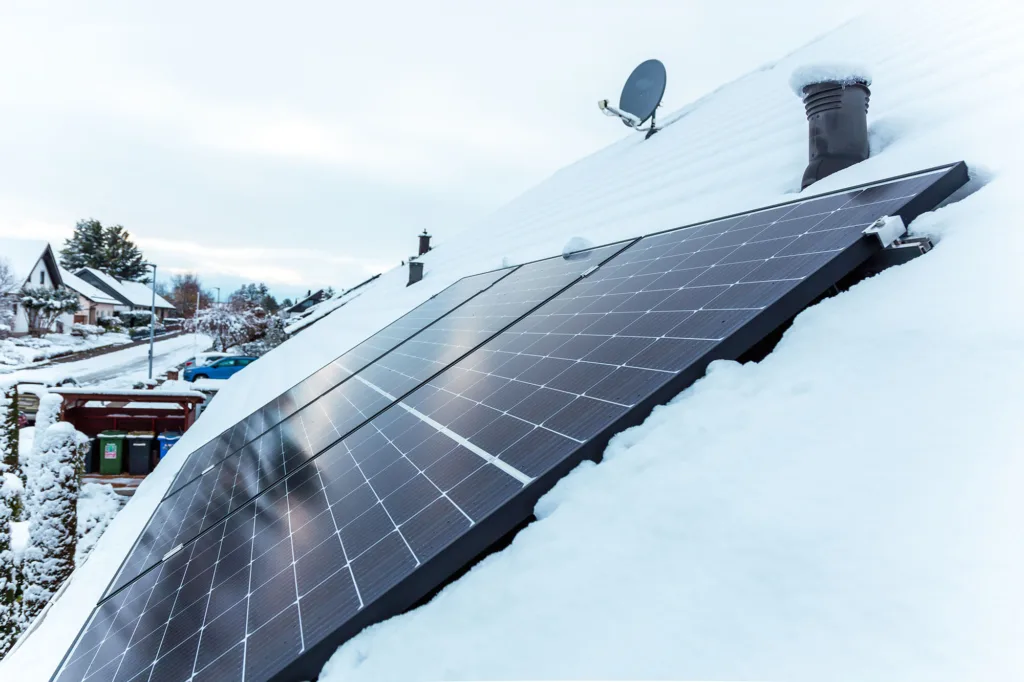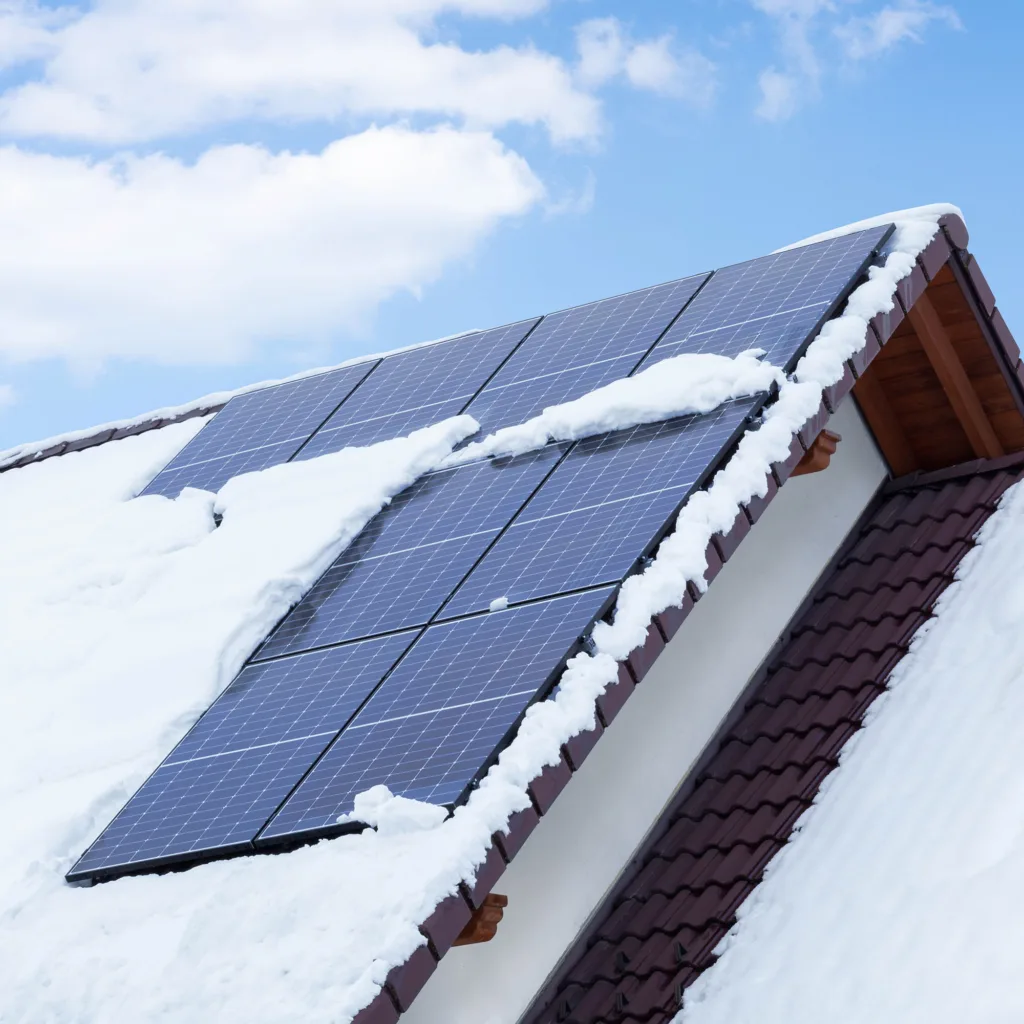In the grey chill of a British winter, it’s easy to assume that solar panels stop working. But here’s the truth: solar panels don’t need blazing sun—they need light. And yes, even in winter, the UK has plenty of that. From Cornwall to the Highlands, modern photovoltaic systems continue generating electricity during colder months. The output may not match summer highs, but the idea that they ‘shut down’ is a myth.
With energy bills biting harder and sustainability climbing the national agenda, understanding how solar panels perform year-round is more relevant than ever. Seasonal changes affect everything from daily energy output to system optimisation. If you’re weighing up whether solar’s still worth it when skies are grey, this article breaks down the facts.
We’ll look at how sunlight, temperature, snow, and system design all play a role in winter energy generation—and how a few smart choices can make a big difference. Plus, if you’re in Cornwall or nearby, there are specific incentives to help make winter solar pay off.
Winter Solar Efficiency in the UK
Winter in the UK presents some clear challenges to solar energy generation—but they’re not deal-breakers. The most obvious factor is reduced daylight. While summer offers up to 16 hours of light per day, winter might see as little as 7 or 8. That naturally means fewer hours for panels to soak up the sun.
But it’s not just about duration. The sun sits lower in the sky in winter, and its rays strike panels at a shallower angle. This reduces the intensity of energy hitting the surface, especially for panels that aren’t optimally tilted. Clouds, rain, and shorter days all contribute to the drop in output.
Still, solar panels work on ambient light, not just direct sunlight. Even on cloudy days, panels can produce a useful amount of electricity. In fact, light diffusion through cloud cover still provides energy—albeit less efficiently.
Another important consideration? Snow. While it’s not as frequent in much of the UK as it is in colder countries, when it does fall, it can block sunlight if left on panels. However, panels are usually installed at a tilt, which helps snow slide off naturally. Plus, the dark surface of the panel warms quickly when exposed to any sunlight, accelerating melt.
If you’re located in a region like Cornwall, which enjoys a milder winter and more annual sunlight than the national average, your seasonal efficiency could be notably better than areas further north.
How Cold Weather Can Actually Help
It might seem counterintuitive, but cold weather can actually boost solar panel efficiency. Photovoltaic (PV) technology doesn’t rely on heat; it relies on light. In fact, high temperatures can reduce the efficiency of solar cells. When the sun is blazing in summer, the panels heat up, and the electrical conductivity in the semiconductors can drop, leading to marginally lower efficiency.
In winter, the lower ambient temperature helps solar panels operate more efficiently—so when the sun is out, even briefly, they can perform at their best. This makes those crisp, clear winter mornings surprisingly productive.
Moreover, the reflective properties of snow—known as the albedo effect—can sometimes increase the amount of light hitting the panels. Clean snow can reflect sunlight back onto the panels from the ground, offering a modest boost to output. Of course, this benefit depends on snow coverage being minimal or promptly cleared.
These environmental quirks are why solar panels are commonly used in cold countries like Germany, Norway, and Canada. The technology is well-suited to low temperatures, provided there’s enough daylight to work with.

Winter Solar Output in Real Numbers
Understanding performance in numerical terms gives a clearer picture. On average, a well-installed 4kW solar system in the UK can produce around 2,800 to 3,400 kWh annually. Of that, winter months (December through February) typically contribute about 10–20% of the yearly total.
In December, the daily output might dip to around 0.5 to 1.5 kWh per day compared to summer peaks of 10 to 12 kWh. While that sounds like a steep drop, remember that energy usage patterns also shift—lighting and heating demand go up, yes, but modern systems with battery storage help smooth this imbalance.
Location matters. In Cornwall, for example, average winter solar irradiation is higher than in much of the UK due to its southern positioning and milder climate. That means homeowners there can expect a better return even in the colder months.
Looking to maximise winter energy output? Explore our solar PV installation services to get a tailored system that works year-round.
Optimising Solar Systems for Winter
Getting the most out of solar panels in winter isn’t just about the weather—it’s about smart setup and maintenance. Panel placement plays a crucial role. A steeper tilt angle, ideally around 60°, helps capture more low-angled winter sunlight and allows snow to slide off more easily. Installers often recommend adjustable mounting systems for year-round efficiency, though fixed angles tailored to winter can also be effective.
Regular maintenance is also key. Panels should be kept clean and clear of debris, leaves, and snow. While rain helps wash panels in summer, manual checks during winter help maintain visibility and performance. It’s also worth trimming back any nearby branches that might create additional shading when the sun is lower.
Battery storage is particularly helpful in winter. When sunlight is sparse, having a battery means you can store excess energy from sunnier days and use it during the darker ones. Pairing panels with a smart inverter system also lets you track usage and output, making it easier to adjust consumption.
Live in Cornwall? Check available solar incentives and winter rebates to make your system more affordable.
Winter Isn’t the End – It’s an Opportunity
Winter may mean shorter days, but it’s also a time when the energy you generate becomes more valuable. With grid prices typically higher in colder months, any power you produce and export earns better returns through feed-in tariffs or smart export guarantees.
It’s also an ideal time to fine-tune your system. Monitoring tools let you identify generation trends and adjust when and how you use your appliances. For example, charging batteries during mid-morning when light is strongest, or timing dishwashers and washing machines to run in daylight hours.
Smart home integration helps you control loads better, and programmable thermostats, when combined with solar power, can significantly reduce heating bills. For households in more exposed regions, adding battery storage becomes even more worthwhile.
Should You Still Go Solar If Winter Is Long?
Absolutely. Solar panels aren’t just about the peak months—they’re about the long-term return. A properly installed system should last over 25 years, and even if winter accounts for a smaller slice of your total energy generation, it still contributes meaningfully to the savings.
In areas with longer winters or more frequent cloud cover, battery storage and system size become critical. You may need slightly more capacity or a more sensitive inverter system to get the same benefit. However, even in Scotland, systems can generate a respectable portion of energy year-round.
Homeowners often see a full return on investment in under 10 years—even quicker when regional incentives and savings on energy bills are factored in. Solar is not just a summer solution—it’s a full-season strategy.
FAQs
Do I need to clean panels in winter?
Yes, occasional cleaning can help, especially after heavy rain or snowfall. Keeping panels clear of grime and snow ensures they absorb as much light as possible, even on overcast days.
Is winter solar viable in all UK regions?
It is, though the output varies. Southern regions like Cornwall see better winter performance due to longer daylight and fewer cloudy days. In the north, efficiency drops more noticeably, but with good system design, it still adds value.
Should I add battery storage just for winter?
If winter output concerns you, battery storage can help by capturing excess energy from brighter days. It’s especially effective if your usage peaks in the evenings when generation is low.
Final Thoughts
The idea that solar panels become useless in winter is a myth. While production naturally dips, modern systems are built to handle the UK’s seasonal swings. With proper installation, smart placement, and optional battery storage, solar remains a solid investment all year round.
The key is not just generating energy, but using it wisely. Winter’s shorter days make energy efficiency even more important—and that’s where monitoring tools and expert advice come in. If you’re serious about solar in any season, don’t let winter put you off. The right setup today can deliver returns every month of the year.
Have questions or need a quote? Get in touch with Wave Electrical Solutions for honest, expert advice tailored to your property.










